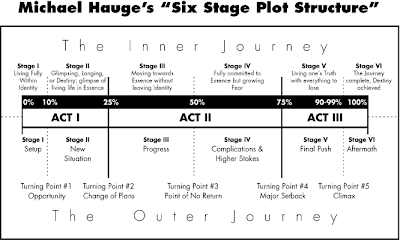In the last few posts I’ve discussed a story’s setting. Today I want to discuss a story’s setting and how it changes in the context of the hero's journey.
Setting Reflects Changes
The setting of a story changes as the story progresses. Often, the setting for each scene mirrors the hero’s arc. (If you’re unfamiliar with the notion of the hero’s journey, I’ve written about it here.)
Just in case all that is clear as mud, let me give you a few examples of what I mean.
Setting Reflects Story
Dichotomies: Tagging the hero and villain
In the movie, The Matrix, Neo, Morpheus and Trinity are dressed in black while their opposition wears business suits.
Here the opposites are agents of order versus agents of chaos. The agents of order (and, yes, they were actually called Agents!) are dressed in business suits and are part of an irredeemably corrupt system.
The agents of chaos, the ones wearing black, are trying to tear down that corrupt system. It was clever to subvert the audience’s expectations and have the good guys wear black. This nicely illustrates that aspects of a setting, such as the clothing/uniform each side wears, helps with characterization. Or, at least it can.
On the topic of business suits, in The Matrix the enemy was an outside force but often the enemy is closer to home, sometimes it even wears a seemingly friendly face. In the movie, The Firm, Mitch McDeer’s opposition was the people he worked beside everyday and they all looked alike. They wore the same thing, they had the same kind of house, the same kind of car (expensive!). They were “one happy family”™. The sameness was part of what made the opposing force so insidious and scary.
Setting Reflects The Protagonist's Need
In general, at the beginning of a story the protagonist has a weakness, a need. For instance, take Susan. She has a weakness that prevents her from realizing her full potential, something that prevents her from living a life that is as meaningful as it could be. In order for Susan to meet this need, she must change. But this is mixed news for Susan because there is no change without destruction, without sacrifice, and that brings turmoil, pain, and possibly death.
The storyteller’s goal is to construct a suitable crucible for heroes-to-be like Susan, one that will challenge her and, ultimately, singe off the bits that have to go to make room for new and improved bits.
The Hero’s Desire
A story world should explain the hero's desire for their goal. In “The Firm,” Mitch McDeere's desire is to never, ever, be poor again and his specific goal is to make partner in a wealthy law firm. At the beginning of the film he’s poor and working as a waiter while still receiving top grades from one of the best law schools in the world, Harvard Law School. That nicely illustrates Mitch’s ambition and intellect.
Here’s another example. (I know I used this example too much!) Luke Skywalker was a skilled pilot but, while his uncle kept promising he could leave the family’s moisture farm and attend the academy, something always came up to prevent it. A droid would break down, the crop wouldn’t be as big as expected, and so on. This meant they couldn’t afford to hire someone to replace Luke, so he felt obliged to stay.
Another thing. I see Luke’s landspeeder as a representation of this conflict between Luke and his family. It reminds us of Luke’s desire to become a pilot as well as the sacrifices he has to make. (That, and landspeeders are just plain cool!)
The Opposing Force
A story wouldn't be much fun if the protagonist wanted something then, without further ado, got it. They must be opposed. This is the job of the antagonistic force that opposes the protagonist in their attempt to attain their goal.
There is a symmetry between the hero and villain. Whatever the hero’s specific goal is, it needs to be something that both the villain and he want, but which at most one of them can achieve. Both can fail but both can never win
The Hero Confronts Death
At some point the hero will suffer a devastating setback. It will seem to him that his quest is over. It is at this point that the hero often has an epiphany, a revelation.
How could the story world reflect this, both the danger and the epiphany?
This is going to sound obvious because it is obvious… I could say ‘dead obvious’ but I think that would be going too far! ;) Anyway. Often the hero confronts death in a setting that brings death to mind. So, how do we do that? What makes us fear? Well, the dark. So caves, dungeons, crypts, pits--sometimes even one’s bedroom at the witching hour! What was that noise? Footsteps? But no one’s home!
In Star Wars IV: A New Hope Luke and his allies are nearly crushed in a trash compactor. Countless movies have the hero visit a creepy old house, or abandoned insane asylum. Perhaps the hero is lured into a cellar, or a dark and musty basement (the Paranormal Activity movies), and then is brought close--even symbolically--to death. (Also, sometimes at this point one of the hero’s allies dies. In a mystery this will often give the hero/sleuth a valuable clue.)
That said, the hero could confront their mortality anywhere; for example, in a law office or as the hero runs through a crowded city. There are no hard and fast rules. The only thing you can take to the bank is that if you don’t write anything you’ll never have a story! So write!
-- --
I think that’s a good place to stop for today. I’ve only blogged half my chapter, so I’ll try and get the second half up tomorrow. In the meantime, good writing!
Other posts in this extended series (I'm blogging a book):
How to Write a Genre Story: The Index






